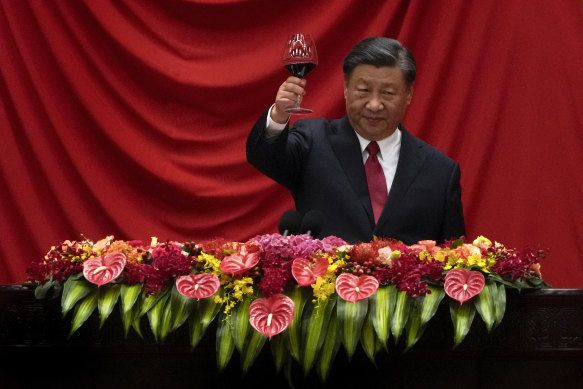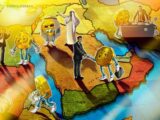
China may meet its growth targets, thanks to last year’s misery
October 19, 2023Save articles for later
Add articles to your saved list and come back to them any time.
The latest data dump from China shows its economy is developing modest momentum, putting it on track to meet its equally modest growth target for this year. It will, however, carry a lot of baggage into 2024.
The September quarter data showed the Chinese economy grew 4.9 per cent compared to the same quarter last year and accelerated from a revised 0.5 per cent in the June quarter to 1.3 per cent in the three months to the end of September. For the year to date, GDP growth was 5.3 per cent.
That almost locks in an annual growth rate around the official target of “about 5 per cent” that the authorities in Beijing were seeking this year. But it’s not as strong as the headline rate might suggest given that last year, the economy was still hit hard by Xi Jinping’s “zero COVID” rolling lockdowns, mass quarantining and severe travel restrictions, generating significant base effects within the year-on-year comparisons.
Chin chin to getting back on track: President Xi Jinping at the Great Hall of the People in Beijing last month. Credit: Getty
Still, China’s authorities will be encouraged that the economy’s trajectory is improving and that the myriad of cautious stimulus efforts – interest rate cuts, measures to increase home sales and sales of home furnishings and other goods, more infrastructure investment and financial assistance to local governments and manufacturers – are starting to have an impact.
They’ll be particularly encouraged by the 5.5 per cent growth in retail sales in September, a lift from the 4.6 per cent growth in August, which suggests that consumer confidence and consumption are picking up. Industrial production grew 4.5 per cent, in line with August’s pace.
Less positive was a slight slowing of the growth in fixed asset investment in the nine months to the end of September, from the 3.2 per cent in the first eight months of the year to 3.1 per cent, and a quickening decline in residential property sales, from minus 1.5 per cent to minus 3.2 per cent. Property investment is down 9.1 per cent compared to the first three quarters of 2022.
Property represents the epicentre of the challenges for the Chinese economy, with home sales falling steadily over the past two years as developers have been engulfed in a crisis triggered by Xi Jinping’s imposition of his “three red lines” restrictions on leverage in 2020.
With the country’s biggest developer, Country Garden, appearing to fail to meet a deadline for an interest payment of $US15.4 million ($24.3 million) due by Wednesday this week at the latest – a default that would trigger cross-defaults on more than $US10 billion of its US dollar-denominated offshore bonds – it is a crisis that keeps expanding and deepening, and which appears to be weighing heavily on consumer confidence and the economy.
With developers toppling at a record rate and home prices continuing to decline, a sector that, with its related activity, has accounted for as much as 30 per cent of China’s GDP will continue to weigh on growth into 2024 and beyond.
The property market’s implosion, excess capacity in factories, local government authorities struggling and constrained by debt levels exposed by the steep fall in their property-related revenues and continuing consumer caution are all threatening deflation.
Prospect of deflation
Data released last week showed China’s consumer prices are flat-lining and producer prices still falling, albeit at a slightly slower rate, indicating that the modest stimulatory efforts so far have failed to gain any traction.
The prospect of deflation is why many outside China expect Beijing to eventually roll out a larger stimulus program, one that’s targeted more directly at Chinese households.
China needs a stronger pick-up in consumption and stronger global growth to absorb overcapacity in its factories if it is to carry the improved momentum into 2024.
The International Monetary Fund recently downgraded its forecasts for China’s growth next year from 4.5 per cent to 4.2 per cent, and now expects its GDP growth to slow to 3.7 per cent in 2027.
There is an expectation that the authorities will make further attempts to stimulate activity, albeit not the large-scale infrastructure-led spending they have resorted to in the past. There is too much debt within the economy and too much past stimulus has been unproductive to reprise that strategy.
Instead, Xi has been focused on subsidising strategic sectors of advanced manufacturing and has made some cautious efforts to stimulate consumption, while trying to encourage a rebound in private sector activity and (unsuccessfully so far) foreign investment.
It’s an economic strategy that is trying to manage a structural shift from an over-reliance on infrastructure investment and property and property-related debt to consumption and advanced manufacturing, but it is a transition with challenges on all fronts, and one complicated by the increasingly tense relationship between China and the US and other Western nations.
There’s hardly a week that goes by without the US or Europe imposing, or threatening to impose, fresh trade restrictions on China.
This week, the US announced additional limits on sales of advanced semiconductors, tightening the restrictions it imposed last year in a move that could stop all sales of advanced chips to China and threaten its ambition of gaining global leadership in sectors like artificial intelligence or advanced military technologies.
Europe is targeting China’s electric vehicle subsidies – one of the sectors Beijing has prioritised – for investigation, and the US and Europe are also trying to negotiate a deal that would see tariffs slapped on China’s steel and aluminium exports.
Coupled with Xi’s own determination to avoid igniting another debt-fuelled speculative bubble in property and other financial assets or adding to the existing portfolio of unproductive state infrastructure and enterprises, those external threats and a declining population represent obstacles to a return to the growth rates China generated before the pandemic, when it appeared likely to challenge the US for the title of the world’s largest economy.
It might still do that but even if it does, it is going to take a lot longer than Xi might have contemplated only a year or so ago.
The Business Briefing newsletter delivers major stories, exclusive coverage and expert opinion. Sign up to get it every weekday morning.
Most Viewed in Business
From our partners
Source: Read Full Article



